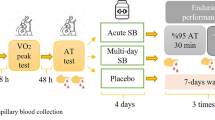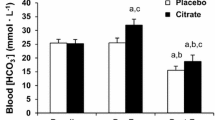Summary
The effects of an alkalising agent were studied in ten subjects who participated in anaerobic testing on a cycle ergometer to determine the effectiveness of sodium citrate (0.5 g·kg−1 body mass) as an ergogenic aid during exercise of 10-s, 30-s, 120-s and 240-s duration. Blood was collected prior to, after ingestion of sodium citrate (NaHCO3), and postexercise, from a heated (43–46°C) fingertip and analysed immediately postcollection for pH, partial pressure of oxygen and carbon dioxide, base excess and blood bicarbonate. Total work undertaken (kJ) and peak power (W) achieved during the tests was also obtained via a work monitor unit. The results indicated that a dose of 0.5 g sdkg−1 body mass sodium citrate had no ergogenic benefit for exercise of either 10-s or 30-s duration. Blood bicarbonate concentrations, however, were significantly increased (P<0.05) following ingestion of the citrate during these trials. Exercise periods of 120 s and 240 s were significantly increased (P<0.05) above the control and placebo conditions following sodium citrate ingestion. Blood bicarbonate concentrations were again increased above control and placebo conditions and blood lactate concentrations were also increased following the citrate trials. The pH decreased significantly (P<0.05) in all trials below the control and placebo conditions. On the basis of the exercise undertaken in this study we would suggest that a dose of 0.5 g·kg−1 body mass of sodium citrate could improve anaerobic exercise performance of 120-s and 240-s duration.
Similar content being viewed by others
References
Bouissou P, Defer G, Guezennec CY, Estrade PY, Serrurier B (1988) Metabolic and blood catecholamine responses to exercise during alkalosis. Med Sci Sports Exerc 20:228–232
Bozzuto TM (1988) Severe metabolic acidosis secondary to exertional hyperlactemia. Am J Emerg Med 6:134–136
Costill DL, Verstappen F, Kuipers H, Janssen E, Fink W (1984) Acid base balance during repeated bouts of exercise: influences of HCO3. Int J Sports Med 5:228–231
Donaldson SKB, Hermansen L (1978) Differential direct effects of H+ and Ca2+-activated force of skinned fibres from the soleus, cardiac, adductor magnus muscle of rabbits. Pflügers Arch 376:55–65
Fabiato A, Fabiato F (1978) Effects of pH on the myofilaments and the sarcoplasmic reticulum of skinned cells from cardiac and skeletal muscles. J Physiol 276:233–235
Forster HV, Dempsey JA, Thompson J, Vidruk E, doPico GA (1972) Estimation of arterial PO2, PCO2, pH and lactate from arterialized venous blood. J Appl Physiol 32:134–137
Goldfinch J, McNaughton LR, Davies P (1988) Bicarbonate ingestion and its effects upon 400-m racing time. Eur J Appl Physiol 57:45–48
Hargreaves M (1990) Introduction. In: Fatigue in Sports and Exercise. Proceedings of the Symposium held in November in the Department of Physical Education and Recreation, Victorian University of Technology, Footscray, p (i)
Hermansen L (1969) Anaerobic energy release. Med Sci Sports 1:32–38
Hermansen L, Osnes J (1972) Blood and muscle pH after maximal exercise in man. J Appl Physiol 32:304–308
Hirche H, Hombach V, Langhor HD, Wacker U (1972) Lactic acid permeation rate in working skeletal muscle during alkalosis and acidosis. Pflügers Arch 332:R73
Horswill CA, Costill DL, Fink WJ, Flynn MG, Kirwan JP, Mitchell JB, Houmard JA (1988) Influence of sodium bicarbonate on sprint performance, relationship to dosage. Med Sci Sports Exerc 20:566–569
Jacobs I, Tesch PA, Bar-Or O, Karlsson J, Dotan R (1983) Lactate in human skeletal muscle after 10 and 30 s of supramaximal exercise. J Appl Physiol Respir Environ Exerc Physiol 55:365–367
Johnson WR, Black DH (1953) Comparison of effects of certain blood alkalinizer and glucose upon competitive endurance performance. J Appl Physiol 5:577–578
Jones NL, Sutton JR, Taylor R, Toews CJ (1977) Effect of pH on cardiorespiratory and metabolic responses to exercise. J Appl Physiol 43:959–964
Katz A, Costill DL, King DS, Hargreaves M, Fink WJ (1984) Maximal exercise tolerance after induced alkalosis. Int J Sports Med 5:107–110
Keppel G (1982) Design and analysis: a researcher's handbook, 2nd edn. Prentice Hall, Englewood Cliffs, N.J.
Lavender G, Bird SR (1989) Effects of sodium bicarbonate ingestion upon repeated sprints. Br J Sports Med 23:41–45
Lehninger AL (1975) Biochemistry, 2nd edn. Worth, New York
Mainwood GW, Cechetto D (1980) The effect of bicarbonate concentration on fatigue and recovery in isolated rat diaphragm. Can J Physiol Pharmacol 58:624–632
Margaria R, Aghemo P, Sassi G (1971) Effects of alkalosis on performance and lactate formation in supramaximal exercise. Int Z Angew Physiol 29:215–223
Maughan RJ, Leiper JB, Litchfield PE (1986) The effects of induced acidosis and alkalosis on isometric endurance capacity in man. In: Dotson CO, Humphrey JH (eds) Exercise physiology, current selected research, vol. 2. AMS Press, New York, pp 73–82
McCartney N, Heigenhauser GFC, Jones NL (1983) Effects of pH on maximal power output and fatigue during short term dynamic exercise. J Appl Physiol Respir Environ Exerc Physiol 55:225–229
McKenzie DC, Coutts KD, Stirling DR, Hoeben HH, Kuzara G (1986) Maximal work production following two levels of artificially induced metabolic alkalosis. J Sports Sci 4:35–38
McLellan TM, Gass GC (1989) Metabolic and cardio-respiratory responses relative to the anaerobic threshold. Med Sci Sports Exerc 21:191–198
Mc Naughton LR (1990) Sodium citrate and anaerobic performance: implications of dosage. Eur J Appl Physiol 61:392–397
Mc Naughton LR (1991) Bicarbonate ingestion: implications of dosage on 60 s cycle ergometry. J Sports Sci (in press)
Mc Naughton LR, Cedaro R (1991) Effects of sodium bicarbonate on rowing ergometer performance in elite rowers. Aust J Sci Med Sport (in press)
Mc Naughton LR, Curtin R, Goodman G, Perry D, Turner B, Showell C (1991) Anaerobic work and power output during cycle ergometer exercise: effects of bicarbonate loading. J Sports Sci 9:151–160
Medbo JI, Sejersted OM (1985) Acid-base and electrolyte balance after exhausting exercise in endurance-trained and sprint-trained subjects. Acta Physiol Scand 125:97–109
Parry-Billings M, MacLaren DPM (1986) The effect of sodium bicarbonate and sodium citrate ingestion on anaerobic power during intermittent exercise. Eur J Appl Physiol 55:224–229
Robin ED (1961) of men and mitochondria: intracellular and sub-cellular acid-base relations. New Engl J Med 265:780–785
Sahlin K (1978) Intracellular pH and energy metabolism in skeletal muscle of man. Acta Physiol Scand 103 [Suppl 455]:1–56
Sahlin K (1990a) Metabolic factors in fatigue. In: Fatigue in sports and exercise. Proceedings of Symposium held in November in the Department of Physical Education and Recreation, Victorian University of Technology, Footscray, pp 23–32
Sahlin K (1990b) Regulation of lactate formation during exercise. In: Fatigue in sports and exercise. Proceedings of Symposium held in November in the Department of Physical Education and Recreation, Victorian University of Technology, Footscray, pp 75–85
Simmons RWF, Hardt AB (1973) The effect of alkali ingestion on the performance of trained swimmers. J Sports Med 13:159–163
Sutton J, Jones N, Toews CJ (1981) Effect of pH on muscle glycolysis during exercise. Clin Sci 61:331–338
Wilkes D, Gledhill N, Smyth R (1983) Effect of acute induced metabolic alkalosis on 800-m racing time. Med Sci Sports Exerc 15:277–280
Author information
Authors and Affiliations
Rights and permissions
About this article
Cite this article
Mc Naughton, L., Cedaro, R. Sodium citrate ingestion and its effects on maximal anaerobic exercise of different durations. Europ. J. Appl. Physiol. 64, 36–41 (1992). https://doi.org/10.1007/BF00376437
Accepted:
Issue Date:
DOI: https://doi.org/10.1007/BF00376437




